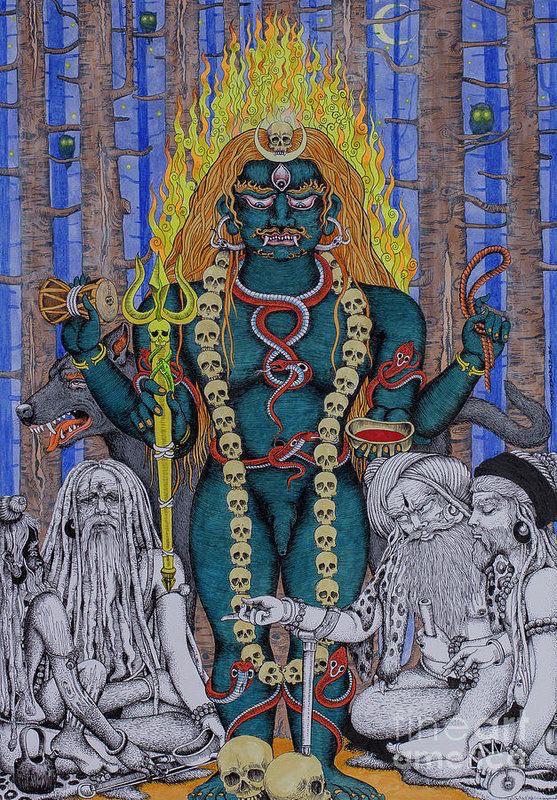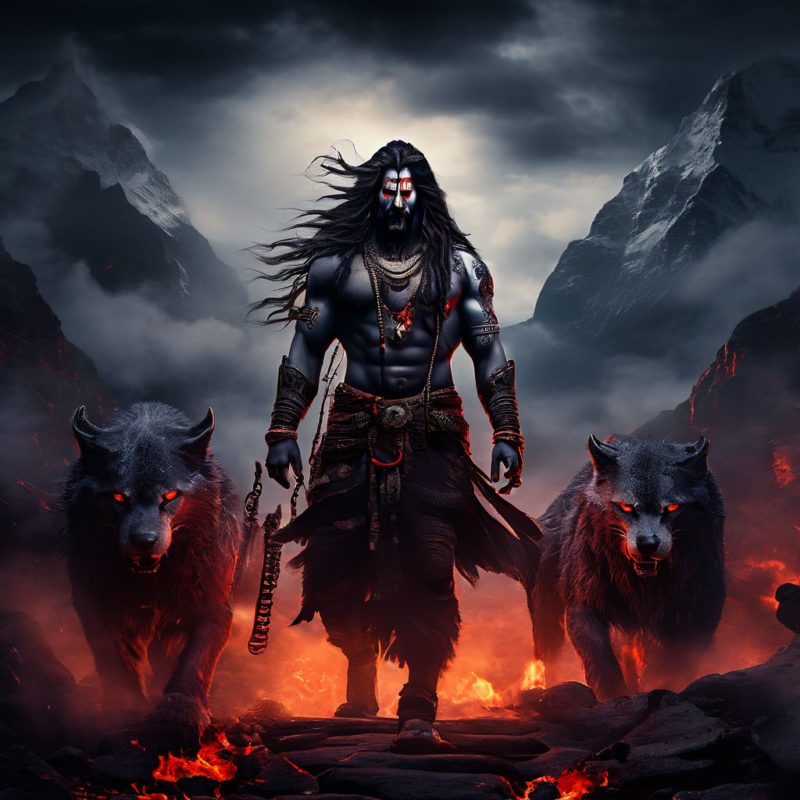The story of Bhairava is deeply rooted in Hindu mythology and is especially significant within Shaivism, the tradition devoted to Lord Shiva. Bhairava is often regarded as a fierce manifestation of Shiva himself, representing destruction, fearlessness, and protection. His story is a blend of cosmic justice, devotion, and metaphysical ideas.
Table of Contents
The Story of Bhairava

The Origin of Bhairava
In ancient times, the universe was governed by various deities, each with their own powers and dominions. At the heart of all creation was Lord Brahma, the creator of the universe, and Lord Vishnu, the preserver. Above all stood Lord Shiva, the supreme destroyer, responsible for the ultimate dissolution of everything to ensure the cycle of creation, preservation, and destruction.
According to the Shiva Purana, a dispute arose between Lord Brahma and Lord Vishnu regarding who was superior. Brahma, in his arrogance, claimed that he was the greatest of all the gods since he was the creator. He even went as far as to belittle Shiva, saying that Shiva’s role as a destroyer was insignificant compared to his task of creation.
Lord Shiva, who was formless and beyond ego, did not engage in the argument initially. But Brahma’s disrespect grew when he developed five heads to represent his creation from all directions. In his arrogance, Brahma claimed that he had the power to oversee the entire universe without the need for Shiva.
Angered by Brahma’s arrogance and his claims of superiority, Lord Shiva manifested Bhairava, a terrifying form representing his power of destruction and annihilation of ego. Bhairava emerged from Shiva’s forehead with an appearance that was both fearsome and awe-inspiring. He carried a trident (Trishula), a skull (Kapala) in his hand, and wore garlands of skulls, signifying his connection with the ultimate truth: that all creation eventually meets its end.
Bhairava Beheads Brahma
As Bhairava emerged, he looked directly at Brahma’s five heads. In a swift and fearless motion, Bhairava severed one of Brahma’s heads with his nail, symbolically cutting down his pride and arrogance. This severed head clung to Bhairava’s hand as a result of Brahma’s curse, which declared that the sin of Brahmahatya (the killing of a Brahmin) would follow him. Bhairava became known as Brahmashiraschedaka Bhairava for beheading Brahma.
Shiva, in his wisdom, did not fully destroy Brahma, acknowledging that creation must continue. However, the act served as a powerful reminder of the dangers of pride, and Brahma’s arrogance was finally subdued.
Bhairava’s Wandering and Redemption
After severing Brahma’s head, Bhairava was cursed to roam the world as an ascetic, carrying the skull (which represents the fifth head of Brahma) as a symbol of his sin. This wandering symbolizes the journey of atonement and purification. Bhairava wandered across various places, begging for alms with the skull, in a state of penance.

He eventually arrived at the sacred city of Varanasi (Kashi), where his sin was absolved. At this point, Bhairava was freed from the curse, and the skull detached from his hand, marking the end of his penance. From that moment, he was revered as the guardian deity of Varanasi. The city, considered the abode of Lord Shiva, is said to be under Bhairava’s protection, and he became known as Kashi Vishwanath Bhairava.
Forms of Bhairava
Bhairava manifests in various forms, each representing a different aspect of Shiva’s power and protection. The most prominent forms are known as the Ashta Bhairavas (the eight Bhairavas), each guarding a particular direction of the universe. These eight forms of Bhairava are:
- Asitanga Bhairava – The protector of the East.
- Ruru Bhairava – The protector of the Southeast.
- Chanda Bhairava – The protector of the South.
- Krodha Bhairava – The protector of the Southwest.
- Unmatta Bhairava – The protector of the West.
- Kapala Bhairava – The protector of the Northwest.
- Bhishana Bhairava – The protector of the North.
- Samhara Bhairava – The protector of the Northeast.
Each form is worshipped for different purposes, ranging from the destruction of enemies and obstacles to the attainment of success, wealth, and protection.
Bhairava in the Spiritual Tradition
Beyond mythology, Bhairava represents the destruction of the ego and the transcendence of fear. In tantric traditions, Bhairava is often considered the ultimate deity who embodies both creation and destruction, showing that these two forces are intertwined in the cycle of existence. His fierce appearance is a reminder that spiritual growth requires the dissolution of attachments and ego, just as Bhairava dissolved Brahma’s pride.
Bhairava is also regarded as the guardian of time. In his form as Kala Bhairava, he is the master of time and space, ensuring that all things happen at their appointed moment. He is often depicted as holding a Damru (drum), symbolizing the rhythm of time, and a Trishula (trident), representing the past, present, and future.
Temples and Worship
Bhairava is especially revered in Varanasi, where he is worshipped as the city’s protector. The Kala Bhairava Temple in Varanasi is one of the most famous shrines dedicated to him. Pilgrims visit to seek his blessings for protection, courage, and the dissolution of ego.
Across India and Nepal, Bhairava is also worshipped in many Shaivite and tantric temples. His festivals, especially during Kalabhairav Jayanti, are marked with great fervor, and devotees offer prayers for protection against evil forces, both external and internal.
Bhairava as a Guardian
In many temples, Bhairava is considered the guardian of the temple grounds. Before entering certain temples, devotees must first seek Bhairava’s permission by offering prayers at his shrine, which is usually located near the entrance. This reflects his role as the gatekeeper who protects against negative energies and helps devotees on their spiritual path.
Questions and Answers based on the story of Bhairava
1. Who is Bhairava?
Answer: Bhairava is a fierce manifestation of Lord Shiva, representing the destructive aspect of his power. He symbolizes fearlessness, destruction of the ego, protection, and time. He is often depicted carrying a trident and a skull and is associated with the end of creation and the dissolution of ignorance.
2. What is the origin of Bhairava?
Answer: Bhairava emerged from Lord Shiva’s forehead in response to Lord Brahma’s arrogance and pride. Brahma claimed superiority over Shiva and grew five heads to symbolize his omnipresence. To humble Brahma and punish his arrogance, Shiva created Bhairava, who beheaded one of Brahma’s heads.
3. Why did Bhairava sever one of Brahma’s heads?
Answer: Bhairava severed one of Brahma’s five heads to punish his pride and arrogance. Brahma had insulted Shiva, claiming that creation was superior to destruction, and even belittled Shiva’s role in the cosmic cycle. Bhairava’s act symbolized the destruction of Brahma’s ego.
4. What curse did Bhairava receive after beheading Brahma?
Answer: After severing Brahma’s head, Bhairava was cursed with the sin of Brahmahatya, the killing of a Brahmin. As a result, he was condemned to roam the world as a wandering ascetic, carrying the skull of Brahma as a reminder of his sin.
5. How did Bhairava’s curse get lifted?
Answer: Bhairava’s curse was lifted when he arrived in Varanasi (Kashi), the sacred city of Lord Shiva. There, his penance ended, and he was absolved of the sin of Brahmahatya. The skull of Brahma detached from his hand, symbolizing his redemption.
6. What is the significance of Bhairava in Varanasi (Kashi)?
Answer: Bhairava is considered the guardian deity of Varanasi, one of the holiest cities in Hinduism. He is worshipped as Kashi Vishwanath Bhairava, and it is believed that he protects the city and its inhabitants. Varanasi is also where Bhairava’s sin was cleansed, and thus he is highly revered there.
7. What are the Ashta Bhairavas?
Answer: The Ashta Bhairavas are the eight forms of Bhairava, each responsible for protecting one direction of the universe. These eight forms are: Asitanga Bhairava (East), Ruru Bhairava (Southeast), Chanda Bhairava (South), Krodha Bhairava (Southwest), Unmatta Bhairava (West), Kapala Bhairava (Northwest), Bhishana Bhairava (North), and Samhara Bhairava (Northeast).
8. What does Bhairava symbolize in the spiritual tradition?
Answer: Bhairava symbolizes the destruction of ego, the transcendence of fear, and the cycle of creation and destruction. In tantric traditions, he is revered as the ultimate deity who governs time and space. Bhairava represents both the fearsome and protective aspects of divinity, guiding spiritual seekers toward liberation from ignorance.
9. What role does Bhairava play in temple worship?
Answer: In many temples, Bhairava is considered the guardian of the temple grounds. Devotees often offer prayers at his shrine before entering the temple to seek his protection and permission. He is believed to guard against negative energies and help devotees on their spiritual path.
10. What is the significance of the skull Bhairava carries?
Answer: The skull Bhairava carries symbolizes the severed head of Brahma and represents the ultimate truth that all creation eventually faces destruction. It is also a reminder of the sin of Brahmahatya, which Bhairava carried as a part of his penance. Additionally, the skull is associated with the impermanence of life and the destruction of ego.
11. What is Kala Bhairava’s role in Hindu mythology?
Answer: Kala Bhairava is the form of Bhairava associated with time. He is regarded as the master of time and space, ensuring that all events occur in their appointed moments. Kala Bhairava is also believed to control the cycles of birth, death, and rebirth, emphasizing that time governs all aspects of existence.
12. What are the offerings made to Bhairava during worship?
Answer: Bhairava is often offered various items during worship, including flowers, sweets, and alcohol, as he is considered a deity who accepts all offerings, even those considered unconventional. Devotees also light oil lamps, offer red flowers, and sometimes even offer symbolic sacrifices to invoke Bhairava’s protection and blessings.
References
- Kramrisch, Stella (1994). The Presence of Śiva. Princeton, NJ: Princeton University Press. p. 471. ISBN 0691019304
- Gopal, Madan (1990). Gautam, K.S. (ed.). India through the ages. Publication Division, Ministry of Information and Broadcasting, Government of India. p. 76.
- “Bhairava: The Wrathful”. Archived from the original on 13 February 2015. Retrieved 13 May 2015.
- Singh, J. (2002). Vijnanabhairava, Or Divine Consciousness: A Treasury of 112 Types of Yoga. Tantra Series. Motilal Banarsidass. p. 1. ISBN 978-81-208-0820-1.
- Sehgal, Sunil (1999). Encyclopaedia of Hinduism: C-G, Volume 2. Sarup & Sons. pp. 491–492. ISBN 978-81-7625-064-1.
- Whalen-Bridge, John; Storhoff, Gary (2009). The Emergence of Buddhist American Literature. State University of New York Press. p. 170. ISBN 978-1-4384-2659-4.
- Davidson, Ronald M. (2003) Indian Esoteric Buddhism: A Social History of the Tantric Movement. Columbia University Press. p. 211. ISBN 0231126190
- The Śiva Purana, Śatarudra Samhita, chapter 8, The Śiva Purana, part III (English translation), Motilal banarsidass Publishers Private Limited, Delhi, reprint edition (2002), pp. 1097–1103.
- Shastri, J. L. (1 January 2000). The Siva Purana Part 1: Ancient Indian Tradition and Mythology Volume 1. Motilal Banarsidass. pp. 57–60. ISBN 978-81-208-3868-0.
- Shastri, J. L. (1 January 2014). The Siva Purana Part 3: Ancient Indian Tradition and Mythology Volume 3. Motilal Banarsidass. pp. 1103–1109. ISBN 978-81-208-3870-3.
